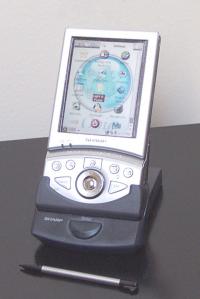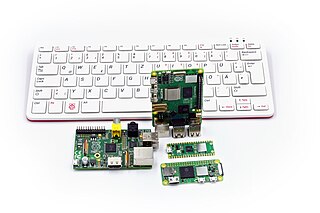
Sharp Zaurus is a series of personal digital assistants (PDAs) made by Sharp Corporation. The Zaurus was the most popular PDA during the 1990s in Japan and was based on a proprietary operating system. The first Sharp PDA to use the Linux operating system was the SL-5000D, running the Qtopia-based Embedix Plus. The Linux Documentation Project considers the Zaurus series to be "true Linux PDAs" because their manufacturers install Linux-based operating systems on them by default. The name derives from the common suffix applied to the names of dinosaurs.

A light-weight Linux distribution a Linux distribution that uses lower memory and processor-speed requirements than a more "feature-rich" Linux distribution. The lower demands on hardware ideally result in a more responsive machine, and allow devices with fewer system resources to be used productively. The lower memory and processor-speed requirements are achieved by avoiding software bloat, i.e. by leaving out features that are perceived to have little or no practical use or advantage, or for which there is no or low demand.

Xubuntu is a Canonical-recognized, community-maintained derivative of the Ubuntu operating system. The name Xubuntu is a portmanteau of Xfce and Ubuntu, as it uses the Xfce desktop environment, instead of Ubuntu's customized GNOME desktop.
The NSLU2 is a network-attached storage (NAS) device made by Linksys introduced in 2004 and discontinued in 2008. It makes USB flash memory and hard disks accessible over a network using the SMB protocol. It was superseded mainly by the NAS200 and in another sense by the WRT600N and WRT300N/350N which both combine a Wi-Fi router with a storage link.

An ultra-mobile PC, or ultra-mobile personal computer (UMPC), is a miniature version of a pen computer, a class of laptop whose specifications were launched by Microsoft and Intel in Spring 2006. Sony had already made a first attempt in this direction in 2004 with its Vaio U series, which was only sold in Asia. UMPCs are generally smaller than subnotebooks, have a TFT display measuring (diagonally) about 12.7 to 17.8 centimetres, are operated like tablet PCs using a touchscreen or a stylus, and can also have a physical keyboard. There is no clear boundary between subnotebooks and ultra-mobile PCs, but UMPCs commonly have major features not found in the common clamshell laptop design, such as small keys on either side of the screen, or a slide-out keyboard.
Kiosk software is the system and user interface software designed for an interactive kiosk or Internet kiosk enclosing the system in a way that prevents user interaction and activities on the device outside the scope of execution of the software. This way, the system replaces the look and feel of the system it runs over, allowing for customization and limited offering of ad-hoc services. KioskTotal Kiosk software locks down the application in order to protect the kiosk from users which is specially relevant under, but not only limited to, scenarios where the device is publicly accessed such libraries, vending machines or public transport. Kiosk software may offer remote monitoring to manage multiple kiosks from another location. An Email or text alert may be automatically sent from the kiosk for daily activity reports or generated in response to problems detected by the software. Other features allow for remote updates of the kiosk's content and the ability to upload data such as kiosk usage statistics. Kiosk software is used to manage a touchscreen, allowing users to touch the monitor screen to make selections. A virtual keyboard eliminates the need for a computer keyboard. Kiosk software enables digital signage devices to operate in a dedicated mode, ensuring that the devices run for a specified purpose, thus providing additional security compared to normal mode use.

My Book is a series of external hard drives produced by Western Digital. There are at least nine series of My Book drives: Essential Edition, Home Edition, Office Edition, Mirror Edition, Studio Edition, Premium Edition, Elite Edition, Pro Edition, AV DVR "Live Edition", and the World Edition.

Dreamlinux was a Brazilian computer operating system based on Debian Linux. It can boot as a live CD, from USB flash drive, or can be installed on a hard drive. The distribution's GUI aims to have a centered animated toolbar. As of October 2012, The Dreamlinux Project has been discontinued.

Zonbu was a technology company that marketed a computing platform which combined a web-centric service, a small form factor PC, and an open source based software architecture. Zonbu was founded by Alain Rossmann and Gregoire Gentil.

The ASUS Eee PC is a netbook computer line from Asus, and a part of the ASUS Eee product family. At the time of its introduction in late 2007, it was noted for its combination of a lightweight, Linux-based operating system, solid-state drive (SSD), and relatively low cost. Newer models added the options of Microsoft Windows operating system and rotating media hard disk drives (HDD), and initially retailed for up to 500 euros.
The Elonex ONE was a netbook computer marketed to the education sector by Elonex. The ONE's operating system was called Linos, based on Linux kernel 2.6.21, and the device had Wi-Fi connectivity, Ethernet networking, a solid-state hard drive, two USB ports and weighed less than 1 kg.

The A110 is a netbook computer by One. It is built on a reference design by Quanta Computer and was announced to run Linpus Linux. However, some or all of the first batch have actually been delivered with a modified Ubuntu Linux installed, using SquashFS to fit the system in the 2 GB Flash memory.

The Skytone Alpha-400 is a Linux-based low-cost netbook with a 7 in 800×480 LCD screen, introduced in 2008. Its measurements (length×width×depth) are 210 mm × 140 mm × 32 mm and it weighs 0.65 kg.

Raspberry Pi is a series of small single-board computers (SBCs) developed in the United Kingdom. The original Raspberry Pi computer was developed by the Raspberry Pi Foundation in association with Broadcom. Since 2012, all Raspberry Pi products have been developed by Raspberry Pi Ltd, which began as a wholly-owned subsidiary of the Foundation.

Leafpad is a free and open-source graphical text editor for Linux, Berkeley Software Distribution (BSD), and Maemo that is similar to the Microsoft Windows program Notepad. Created with the focus of being a lightweight text editor with minimal dependencies, it is designed to be simple-to-use and easy-to-compile.
The MK802 is a PC-on-a-stick produced by Rikomagic, a Chinese company using mostly two series of systems on a chip architectures:

Intel Galileo is the first in a line of Arduino-certified development boards based on Intel x86 architecture and is designed for the maker and education communities. Intel released two versions of Galileo, referred to as Gen 1 and Gen 2. These development boards are sometimes called "Breakout boards".

Banana Pi is a line of single-board computers produced by the Chinese company Shenzhen SINOVOIP Company, its spin-off Guangdong BiPai Technology Company, and supported by Hon Hai Technology (Foxconn). Its hardware design was influenced by the Raspberry Pi, and both lines use the same 40-pin I/O connector.
Twister OS is a 32-bit Operating System created by Pi Labs for the Raspberry Pi single board computer originally, with a x86_64 PC version released a few months later. Twister is meant to be a general-purpose OS that is familiar or nostalgic to users. Twister is based on Raspberry Pi OS Lite and uses the XFCE desktop environment. Twister OS also has a version called "Twister OS Armbian" designed for ARM SBCs with the RK3399 CPU. There are four versions of the operating system, TwisterOS Full, Twister OS Lite, Twister UI and Twisters OS Armbian.














